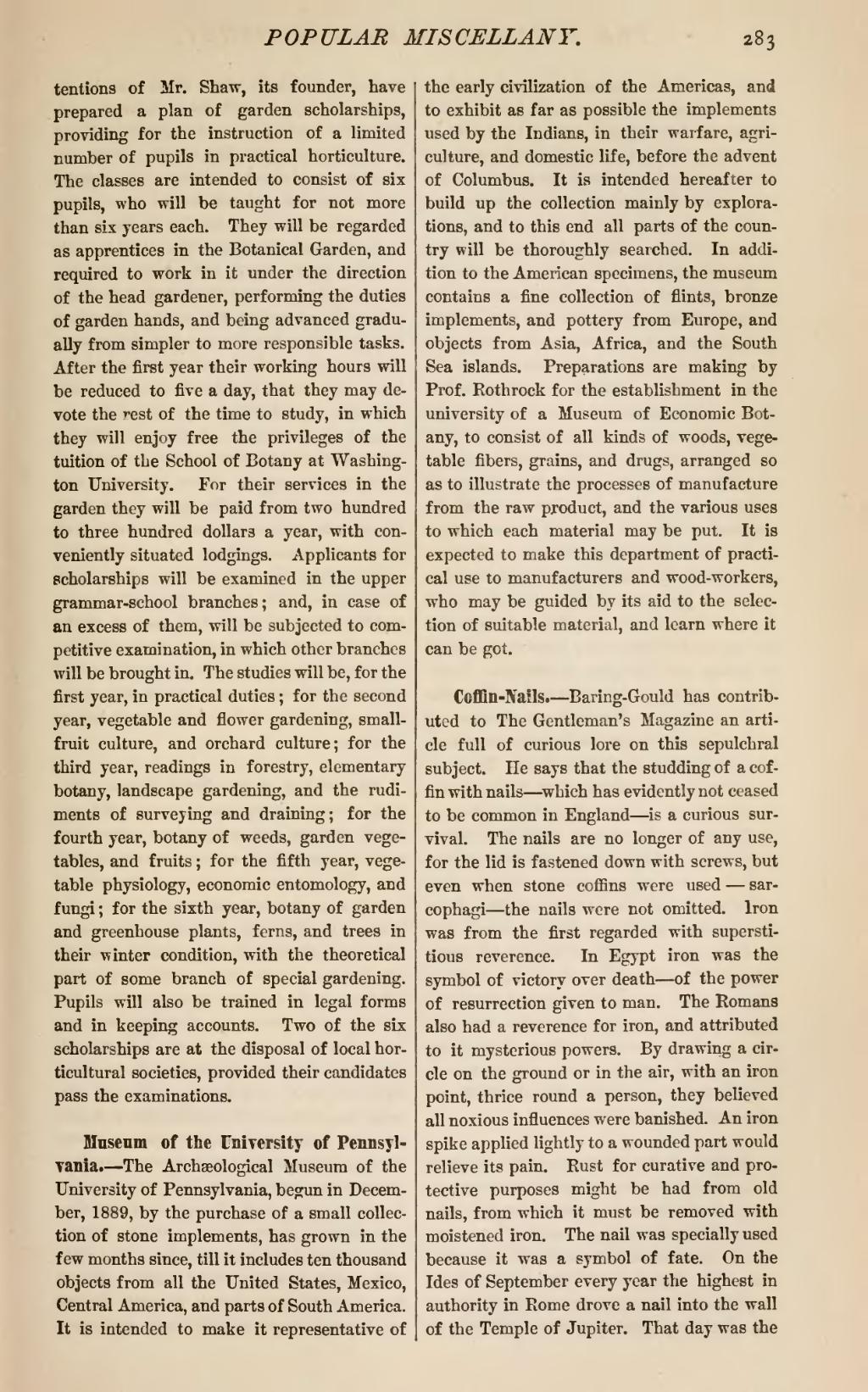tentions of Mr. Shaw, its founder, have prepared a plan of garden scholarships, providing for the instruction of a limited number of pupils in practical horticulture. The classes are intended to consist of six pupils, who will be taught for not more than six years each. They will be regarded as apprentices in the Botanical Garden, and required to work in it under the direction of the head gardener, performing the duties of garden hands, and being advanced gradually from simpler to more responsible tasks. After the first year their working hours will be reduced to five a day, that they may devote the rest of the time to study, in which they will enjoy free the privileges of the tuition of the School of Botany at Washington University. For their services in the garden they will be paid from two hundred to three hundred dollars a year, with conveniently situated lodgings. Applicants for scholarships will be examined in the upper grammar-school branches; and, in case of an excess of them, will be subjected to competitive examination, in which other branches will be brought in. The studies will be, for the first year, in practical duties; for the second year, vegetable and flower gardening, smallfruit culture, and orchard culture; for the third year, readings in forestry, elementary botany, landscape gardening, and the rudiments of surveying and draining; for the fourth year, botany of weeds, garden vegetables, and fruits; for the fifth year, vegetable physiology, economic entomology, and fungi; for the sixth year, botany of garden and greenhouse plants, ferns, and trees in their winter condition, with the theoretical part of some branch of special gardening. Pupils will also be trained in legal forms and in keeping accounts. Two of the six scholarships are at the disposal of local horticultural societies, provided their candidates pass the examinations.
Museum of the University of Pennsylvania.—The Archæological Museum of the University of Pennsylvania, begun in December, 1889, by the purchase of a small collection of stone implements, has grown in the few months since, till it includes ten thousand objects from all the United States, Mexico, Central America, and parts of South America. It is intended to make it representative of the early civilization of the Americas, and to exhibit as far as possible the implements used by the Indians, in their warfare, agriculture, and domestic life, before the advent of Columbus. It is intended hereafter to build up the collection mainly by explorations, and to this end all parts of the country will be thoroughly searched. In addition to the American specimens, the museum contains a fine collection of flints, bronze implements, and pottery from Europe, and objects from Asia, Africa, and the South Sea islands. Preparations are making by Prof. Rothrock for the establishment in the university of a Museum of Economic Botany, to consist of all kinds of woods, vegetable fibers, grains, and drugs, arranged so as to illustrate the processes of manufacture from the raw product, and the various uses to which each material may be put. It is expected to make this department of practical use to manufacturers and wood-workers, who may be guided by its aid to the selection of suitable material, and learn where it can be got.
Coffin-Nails.—Baring-Gould has contributed to The Gentleman's Magazine an article full of curious lore on this sepulchral subject. He says that the studding of a coffin with nails—which has evidently not ceased to be common in England—is a curious survival. The nails are no longer of any use, for the lid is fastened down with screws, but even when stone coffins were used—sarcophagi—the nails were not omitted. Iron was from the first regarded with superstitious reverence. In Egypt iron was the symbol of victory over death—of the power of resurrection given to man. The Romans also had a reverence for iron, and attributed to it mysterious powers. By drawing a circle on the ground or in the air, with an iron point, thrice round a person, they believed all noxious influences were banished. An iron spike applied lightly to a wounded part would relieve its pain. Rust for curative and protective purposes might be had from old nails, from which it must be removed with moistened iron. The nail was specially used because it was a symbol of fate. On the Ides of September every year the highest in authority in Rome drove a nail into the wall of the Temple of Jupiter. That day was the

